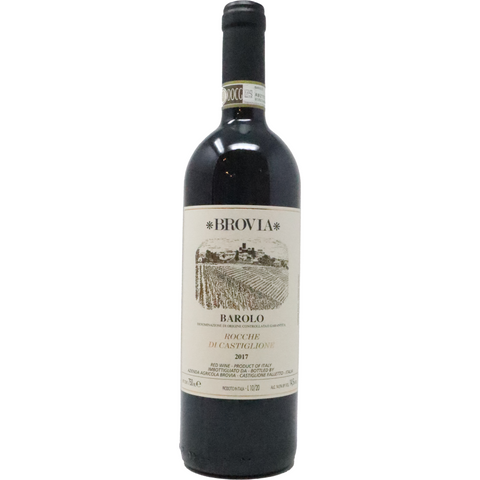
2018 Brovia Barolo Rocche di Castiglione, Piedmont, Italy
Rose petal, blue flower, wild berry, baking spice, menthol and new leather aromas graciously ascend from the glass. The palate has luscious pomegranate, red cherry, licorice and chopped mint alongside taut, lithe tannins and bright acidity.
ABOUT THIS WINE
After total destemming, the wine ferments spontaneously in concrete vats. Cuvaison lasts 21-30 days. The wine remains on lees until racking following malolactic which occurs spontaneously, in vat following alcoholic fermentation. Élevage sees 24 months in 30-hl Slavonian and French oak botti. Free-run juice only. Bottled unfined and unfiltered.
ABOUT THIS PRODUCER
In 1863 Giacinto Brovia founded the Brovia estate in the village of Castiglione Falletto, in the heart of the Barolo district. The family has been continually engaged in the growing of grapes and the production of wine since that time. The phylloxera plague, economic upheaval and two wars interrupted production for almost 30 years but, in 1953, two brothers, Giacinto and Raffaele, grandchildren of the founder, resumed full-scale wine production. Giacinto, a trained enologist, was responsible for the production of the wine while Raffaele, a trained agronomist, supervised the vineyard work. Sadly, Raffaele passed away in 2011, and Giacinto in 2014, but Giacinto’s daughter Elena and her husband Alex Sanchez are now completely engaged as the fourth generation in the affairs of this family-run estate. For our part, Rosenthal Wine Merchant has worked in close collaboration with the Brovia family for several decades, having made our first purchases in the exceptional 1978 vintage.
The Brovias, from generation to generation, have been conscientious buyers of some of the finest vineyard sites in this noble zone, concentrating their efforts in their home village of Castiglione Falletto and the neighboring Serralunga d’Alba. Brovia owns land in a variety of the best “cru” of Piedmont such as Rocche, Villero and Garblét Sue, all in Castiglione Falletto, as well as Brea in Serralunga. These different vineyard plots represent a range of soil types, from heavier clay to friable limestone. The Brovias are extremely conscientious winegrowers and farm organically in every sense of that word (without being formally certified). They perform soil analyses every two years to ensure that the elements are in equilibrium; pruning is done to limit harvest levels; and grape clusters are thinned, when necessary, in the summer. Harvest is done entirely by hand and usually begins in late September with the Dolcetto, Arneis and Barbera; of course, the Nebbiolo ripens later, and harvest for the various Baroli occurs normally in mid-October.
The Brovia wines are vinified in the classic style. Grapes are lightly crushed before going into the fermentation tanks. The length of the fermentation period depends on the grape variety but the Nebbiolo for various Barolo cuvées can extend as long as a month or more at temperatures between 28 and 30 degrees Celsius. The Baroli are aged for at least two years in 30 hectoliter barrels of Slavonian and French oak. The wines are then bottled without filtration and released to the market after an additional 18 to 24 months of bottle-aging. The cuvées of Dolcetto and Barbera are handled differently, with the Dolcetto being aged exclusively in stainless steel tanks and the Barbera in stainless with a portion of the Serralunga-based wine in smaller barrels (more detail is provided below)., with a portion going into French oak barrels for 9 – 10 months. The wines are bottled without filtration.
The Brovia estate encompasses 19.2 hectares with 55% of the production dedicated to Barolo, 25% in Dolcetto, 10% to Barbera and the remaining 10% produced from Arneis, Nebbiolo d’Alba and Freisa.
